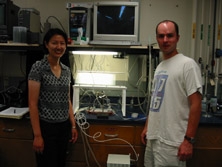
School:
Grade Level:
Teaching Position:
Supervisor:
Department:
Mentor:
Research Project Year:
Research Project Title:
Research Project Description:
Our lungs have an inside coating of surfactant that helps the alveoli expand and compress without collapsing. There is a thin layer of water inside the alveoli that functions at a high surface tension. If no surfactant was present, the energy required to breathe would be too great to overcome by our bodies. Fortunately, lung surfactant reduces the surface tension of the alveolar water and so makes breathing possible.
Current research on lung surfactants began with the goal of helping premature infants with Respiratory Distress Syndrome (RDS). Humans first synthesize lung surfactant about a month before birth. Babies born prior to surfactant synthesis suffer from poor lung expansion, inadequate gas exchange, and a gradual collapse of the lungs. Surfactants derived from animals are intubated into the premature infant upon birth to combat the effects of RDS. Hospitals currently use three brands of surfactant: Survanta (bovine), Curosurf (porcine), and Infasurf (calf).
My research goal for this summer was to study how lung surfactants collapse and respread in a simulated environment. Lung surfactant was found to consist primarily of phospholipids, with trace amounts of cholesterol and proteins. The surfactants?collapse? when they are compressed to a small enough area per molecule and?recover? when expanded. Ideally, lung surfactant should collapse, possibly sink into the subphase (buffer), and return to the surface of the air-water interface. I employed the use of the Langmuir-Blodgett trough and the Atomic Force Microscope to make samples of surfactant and carefully observe them. One of my experiments was to test the effects of high salt concentration on Survanta. Salt was found to improve the recovery rate of Survanta. This could possibly be due to the fact that the Na and Cl ions reduced the repulsive forces among the surfactant phospholipids and thus allowed them to return to the surface of the air-water interface.
Research Project Attachments:
| Attachment | Size |
|---|---|
| 1.93 MB |
Curriculum Project Year:
Curriculum Project Title:
Curriculum Project Description:
After six weeks of research in an authentic scientific setting, I came away with skills not often fostered in classrooms but nonetheless indispensable to the advancement of real world science. My curriculum project centers on the incorporation of three aspects of research that I found prevalent in laboratories but somewhat lacking in my classroom: COLLABORATION, CONSTRUCTIVE CRITICISM, and COMMUNICATION. Collaboration fosters a sense of responsibility for each group involved in a project as each is expected to make a valid contribution to the activity at hand. Constructive criticism refines student work and encourages them to seek improvement. Students learn better when they teach the concept to someone else. By the sheer act of communication, it forces the student to process the information into digestible bits and convey it to another. This curriculum project will manifest itself throughout the year in the form of jigsaw labs, debates, and projects that have opportunities for peer review and oral presentations incorporated into them. The activities will be geared towards the 6th grade Earth Science and Health curricula and address the California Earth Science and Health standards.
Curriculum Project Attachments:
| Attachment | Size |
|---|---|
| 504 KB |
